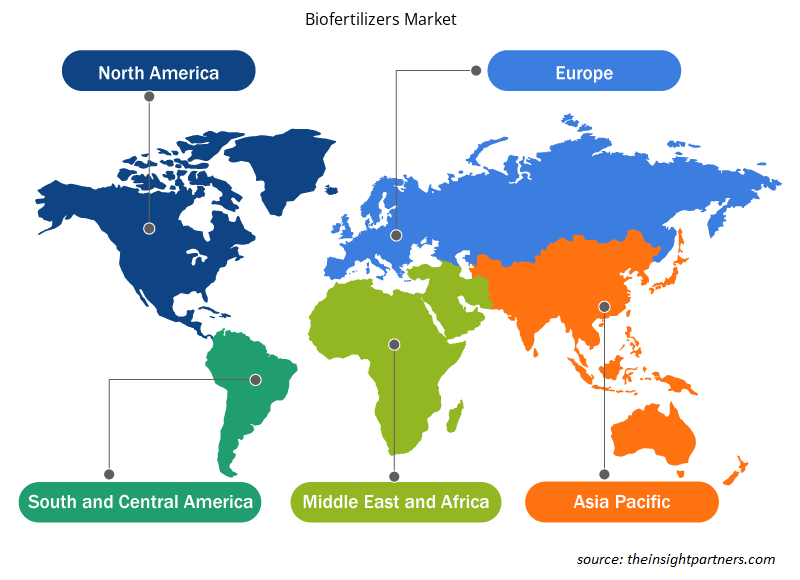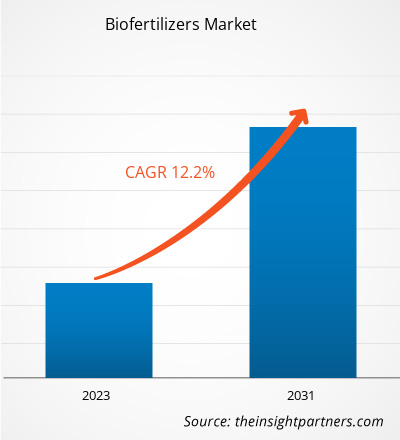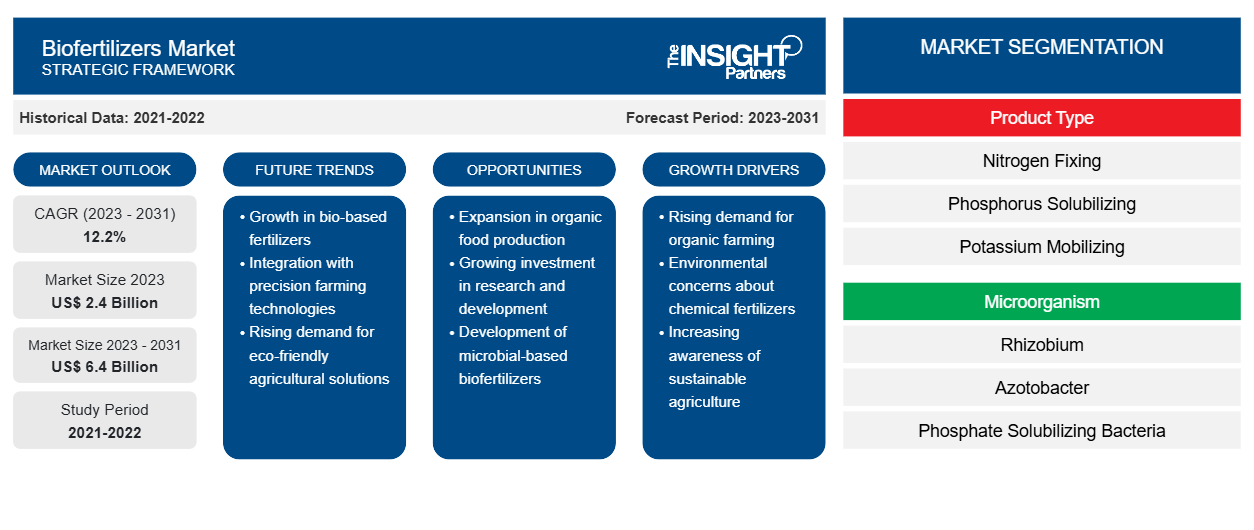生物肥料市场规模预计将从 2023 年的 24 亿美元增至 2031 年的 64 亿美元。预计 2023-2031 年期间,市场复合年增长率将达到 12.2%。制造公司越来越注重创新,提供新产品以提升客户体验,这可能仍是生物肥料市场的主要趋势。
生物肥料市场分析
有机农业方法包括利用生物材料种植和培育农作物,不使用合成肥料。为了生产出健康、高品质的食品,人们越来越多地采用有机农业。除此之外,有机农业还具有多种环境效益,例如,它可以提高土壤肥力、防止水土流失、减少温室气体排放。生物肥料是有机农业实践的重要组成部分之一,因为它将天然微生物与有机衍生的营养丰富的肥料结合在一起,为植物和土壤提供健康的生长环境。生物肥料还有助于增强植物对害虫和非生物胁迫(如干旱、过量水分和极端温度变化)的抵抗力。因此,由于全球消费者越来越多地采用有机产品,有机农业迅速增长,从而推动了生物肥料市场的增长。
生物肥料市场概况
生物肥料由微生物和活细菌组成,可提高土壤肥力和促进植物生长。这些微生物支持固氮过程,产生植物生长所必需的成分。生物肥料以其成本效益和环保性而闻名。由于农业向可持续方向发展,生物肥料市场需求旺盛。人们对有机农业的兴趣日益浓厚,政府的支持也为生物肥料行业带来了繁荣。因此,生物肥料市场预计将在预测期内实现增长。
定制此报告以满足您的需求
您可以免费定制任何报告,包括本报告的部分内容、国家级分析、Excel 数据包,以及为初创企业和大学提供优惠和折扣
-
获取此报告的关键市场趋势。这个免费样品将包括数据分析,从市场趋势到估计和预测。
生物肥料市场驱动因素和机遇
政府举措不断加强,可持续农业技术意识不断增强
各国政府都在采取措施推动生物肥料的采用。例如,在印度,各邦政府一直通过“Paramparagat Krishi Vikas Yojana (PKVY)”和“东北地区有机价值链发展计划 (MOVCDNER)”等计划或方案支持使用生物肥料,而不是化学肥料或合成肥料。此外,欧盟 (EU) 的“共同农业政策”旨在促进整个地区的生物资源利用。因此,政府举措以及现代农业对可持续性的日益倾向引发了全球对生物肥料的需求。
农作物产量和单产增加
生物肥料的应用是可持续农业系统的潜在技术之一。农民广泛使用固氮磷溶解生物肥料来生产小麦、油籽和水稻等高需求作物。因此,生物肥料中包含不同的微生物,有助于提高作物的产量和产量,从而为全球生物肥料市场提供各种增长机会。
生物肥料市场报告细分分析
有助于得出生物肥料市场分析的关键部分是产品类型、微生物、作物类型和应用。
- 根据产品类型,生物肥料市场分为固氮、磷溶解、钾动员等。固氮部分在 2023 年占据了最大的市场份额。
- 根据微生物,市场分为根瘤菌、固氮菌、磷酸盐溶解细菌等。根瘤菌在 2023 年占据了最大的市场份额。
- 就作物类型而言,市场分为谷物和谷类、油籽和豆类、水果和蔬菜等。2023 年,谷物和谷类占据了市场主导地位。
- 根据应用,市场分为种子处理、土壤处理和其他。种子处理领域在 2023 年占据了市场主导地位。
生物肥料市场份额按地区分析
生物肥料市场报告的地理范围主要分为五个地区:北美、亚太、欧洲、中东和非洲、南美/南美和中美。
北美主导着生物肥料市场。北美是生物肥料市场的主要地区之一,因为该地区无化学和有机食品的消费量不断增加。此外,美国是全球生物肥料的主要生产国之一;尽管化学肥料通常不被贴上“健康”的标签,但消费者仍在寻找更健康的替代品,如生物肥料。根据美国能源部和美国农业部的数据,市场驱动因素之一是生物质原料供应充足。这些都是推动北美国家对生物肥料需求的一些因素。预计亚太地区未来几年将以最高的复合年增长率增长。
生物肥料市场区域洞察
Insight Partners 的分析师已详尽解释了预测期内影响生物肥料市场的区域趋势和因素。本节还讨论了北美、欧洲、亚太地区、中东和非洲以及南美和中美洲的生物肥料市场细分和地理位置。

- 获取生物肥料市场的区域特定数据
生物肥料市场报告范围
| 报告属性 | 细节 |
|---|---|
| 2023 年的市场规模 | 24亿美元 |
| 2031 年市场规模 | 64亿美元 |
| 全球复合年增长率(2023 - 2031) | 12.2% |
| 史料 | 2021-2022 |
| 预测期 | 2023-2031 |
| 涵盖的领域 |
按产品类型
|
| 覆盖地区和国家 |
北美
|
| 市场领导者和主要公司简介 |
|
生物肥料市场参与者密度:了解其对业务动态的影响
生物肥料市场正在快速增长,这得益于终端用户需求的不断增长,而这些需求又源于消费者偏好的不断变化、技术进步以及对产品优势的认识不断提高等因素。随着需求的增加,企业正在扩大其产品范围,进行创新以满足消费者的需求,并利用新兴趋势,从而进一步推动市场增长。
市场参与者密度是指在特定市场或行业内运营的企业或公司的分布情况。它表明在给定市场空间中,相对于其规模或总市场价值,有多少竞争对手(市场参与者)存在。
在生物肥料市场运营的主要公司有:
- 农业生命
- 生物科技国际有限公司
- 康坦生物科技产品集团公司
- Mapleton Agri Biotec Pt Ltd.
- 诺维信
- 根瘤菌
免责声明:上面列出的公司没有按照任何特定顺序排列。

- 了解生物肥料市场主要参与者概况
生物肥料市场新闻和最新发展
生物肥料市场通过收集一级和二级研究后的定性和定量数据进行评估,其中包括重要的公司出版物、协会数据和数据库。以下是言语和语言障碍市场的发展列表:
- 先正达生物制品公司和 Unium Bioscience 宣布合作,为欧洲西北部的农民提供基于 NUELLO® iN 的突破性生物种子处理解决方案。(来源:先正达,简报,2023 年)
- Performance Nutrition 推出了其 NutriWise 品牌,这是一种颗粒肥料和水溶性粉末,将取代旧的 NutriSmart 产品线。新产品适用于农业、草坪和观赏市场。(来源:LidoChem, Inc.,新闻稿,2022 年)
生物肥料市场报告覆盖范围和交付成果
“生物肥料市场规模和预测(2021-2031)”报告对以下领域进行了详细的市场分析:
- 范围内涵盖的所有主要细分市场的全球、区域和国家层面的市场规模和预测
- 市场动态,如驱动因素、限制因素和关键机遇
- 未来主要趋势
- 详细的 PEST/波特五力分析和 SWOT 分析
- 全球和区域市场分析涵盖关键市场趋势、主要参与者、法规和最新市场发展
- 行业格局和竞争分析,涵盖市场集中度、热点图分析、知名参与者和最新发展
- 详细的公司简介
- 历史分析(2 年)、基准年、预测(7 年)及复合年增长率
- PEST和SWOT分析
- 市场规模、价值/数量 - 全球、区域、国家
- 行业和竞争格局
- Excel 数据集
近期报告
客户评价
购买理由
- 明智的决策
- 了解市场动态
- 竞争分析
- 客户洞察
- 市场预测
- 风险规避
- 战略规划
- 投资论证
- 识别新兴市场
- 优化营销策略
- 提升运营效率
- 顺应监管趋势























 获取免费样品 - 生物肥料市场
获取免费样品 - 生物肥料市场